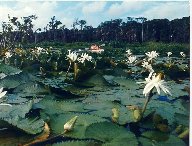Trinidad and Tobago's Nariva Swamp removed from the Montreux Record

The Montreux Record was established in 1990 as a register of wetlands on the List of Wetlands of International Importance where changes in ecological character have occurred, are occurring, or are likely to occur as a result of technological developments, pollution or other human interference. Resolution 5.4 (Kushiro, 1993) determined that the Montreux Record should be employed to identify priority sites for positive national and international conservation attention. Guidelines for adding and removing sites to and from the Montreux Record were agreed by the Parties in Resolution VI.1 (Brisbane, 1996).
 The Nariva Swamp (6,234 hectares) in Trinidad and Tobago was designated for the Ramsar List on 21 December 1992 - in June 1993 the Government requested that Nariva be added to the Montreux Record because of a number of adverse changes in ecological character: fragmentation of evergreen forest and loss of herbaceous swamp, disappearance of open water and saltwater intrusion, water mismanagement for unlawful large-scale rice cultivation, land tenure problems and squatting, amongst others. In April/May 1995 a Ramsar Advisory Mission, led by Dr Montserrat Carbonell, then of the Ramsar Bureau, and invited experts Dr Mike McCoy of the Universidad Nacional of Costa Rica and Lirio Márquez of Puerto Rico, in cooperation with officials of a number of government departments and NGOs, was undertaken to offer expert advice to remedy the situation. In November 1997, Dave Pritchard of RSPB and BirdLife International studied the situation in Trinidad and Tobago at length on his sabbatical and wrote a report in which, among other recommendations, he urged the development of a National Wetland Policy as a key prerequisite for further progress. In 1998, an emergency grant from the Ramsar Small Grants Fund assisted in urgent infrastructure works to extinguish fires that had run wild, largely because of irrigation ditches constructed by illegal industrical rice farmers.
The Nariva Swamp (6,234 hectares) in Trinidad and Tobago was designated for the Ramsar List on 21 December 1992 - in June 1993 the Government requested that Nariva be added to the Montreux Record because of a number of adverse changes in ecological character: fragmentation of evergreen forest and loss of herbaceous swamp, disappearance of open water and saltwater intrusion, water mismanagement for unlawful large-scale rice cultivation, land tenure problems and squatting, amongst others. In April/May 1995 a Ramsar Advisory Mission, led by Dr Montserrat Carbonell, then of the Ramsar Bureau, and invited experts Dr Mike McCoy of the Universidad Nacional of Costa Rica and Lirio Márquez of Puerto Rico, in cooperation with officials of a number of government departments and NGOs, was undertaken to offer expert advice to remedy the situation. In November 1997, Dave Pritchard of RSPB and BirdLife International studied the situation in Trinidad and Tobago at length on his sabbatical and wrote a report in which, among other recommendations, he urged the development of a National Wetland Policy as a key prerequisite for further progress. In 1998, an emergency grant from the Ramsar Small Grants Fund assisted in urgent infrastructure works to extinguish fires that had run wild, largely because of irrigation ditches constructed by illegal industrical rice farmers.
Having undertaken to implement the extensive recommendations of the Ramsar Advisory Mission report, the Government, and particularly the dedicated Nadra Nathai-Gyan of the Wildlife Section of the Forestry Division, began the Resolution VI.1 procedure for removing Ramsar sites from the Montreux Record. Reports of infrastructure works, removal of large-scale agricultural squatters, an EIA, amongst other initiatives, culminated in the adoption by the Cabinet on 11 July 2001 of a "National Policy and Programmes on Wetland Conservation for Trinidad and Tobago", thus completing the Resolution VI.1 process for removal.
Thus, on the recommendation of Ramsar Regional Coordinator Margarita Astrálaga, the Secretary General has warmly welcomed Trinidad and Tobago's request and instructed that the Nariva Swamp be deleted from the Montreux Record effective January 2002, when the removal paperwork was completed. The Bureau sends its congratulations to Trinidad and Tobago for these positive developments and its best wishes for continued progress with Nariva Swamp and the other wetlands with its territory.